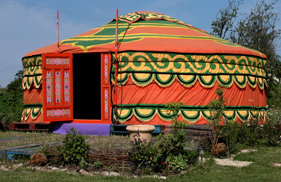 If you know what a yurt is, then you know they’re found in Mongolia. This round home designed by nomads is part of the housing traditions in the steppes of Central Asia.
If you know what a yurt is, then you know they’re found in Mongolia. This round home designed by nomads is part of the housing traditions in the steppes of Central Asia.
Primarily made of felt, the perfect insulating material, a yurt can be put up or taken down in a few hours, some in less than 30 minutes. That’s why the Mongol invaders lugged them around everywhere they went in Europe in their wars of conquest in the 1200s. Remember Attila, Genghis Khan, the famous Golden Horde that sowed panic from Russia to the Great Wall of China to Hungary.
There was a time when yurts were transported on wheels. That was in the first years that these types of homes existed, about 2,000 years ago. Yurts became lighter over the years, probably to meet nomadic needs.
The interior of the classic yurt consists of a large, single room with beds set out on each side, a table, wood boxes for storage, a door facing the southern sun, but no windows. Today there are bigger yurts that can reach up to six to eight metres in diameter and are more than two metres high.
A yurt is like a cousin to our tents or Indian tepees. It’s still one of the most popular types of home in the Asian steppes, even in 2011.
If you’re interested, you can sleep in a yurt in Quebec. The Parcs Québec network has 28 yurts. The tent is a round fabric mounted on a hardwood floor, topped by a skylight. Unlike the traditional yurt, windows are abundant.